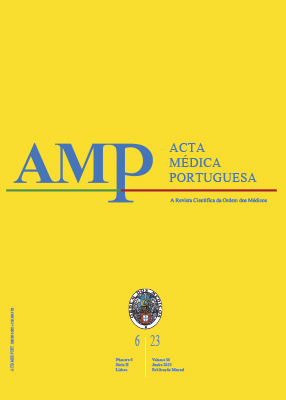Long-Term Reversible Contraception in Adolescence: The Reality of a Tertiary Pediatric Hospital in Portugal
DOI:
https://doi.org/10.20344/amp.18753Keywords:
Adolescent, Contraception, Long-Acting Reversible ContraceptionAbstract
Introduction: Contraception in adolescence is essential to prevent unwanted pregnancies, abortion and sexually transmitted diseases. The use of longacting reversible contraceptive methods (LARCs) has been highly recommended due to their efficacy since they are user independent methods. The aim of this study was to evaluate the use of LARCs in adolescence in the population of a Childhood and Adolescence Gynecology clinic, and to describe the sociodemographic characteristics of the adolescents as well as previous contraceptive practices.
Material and Methods: Retrospective analysis that included adolescents using LARCs, monitored in a Childhood and Adolescence Gynecology clinic of a Portuguese tertiary pediatric hospital, between June 2012 and June 2021.
Results: A total of 122 adolescents were included, with a median age of 16 (11 – 18) years and 62.3% (n = 76) were sexually active. The preferred method was the subcutaneous implant, placed in 82.3% (n = 101), followed by the Levonorgestrel-Intrauterine System in 16.4% (n = 20) and the copper intrauterine device in 1.3% (n = 1). The main indications for LARCs were contraceptive needs 90.2% (n = 110), abnormal uterine bleeding during puberty in 14.8% (n = 18), dysmenorrhea in 10.7% (n = 13) and need for amenorrhea in 0.8% (n = 1). The median time of implant use was 20 (1 – 48) months and of the LNG-IUS it was 20 (1 – 36) months. The 12-month adherence rate for both was 76.2% (n = 93). The removal rate for reasons besides the expiration date was 9.8% (n = 12) in adolescents who had implants, and no LNG-IUS or copper intrauterine devices were removed. There were no pregnancies after insertion of LARCs.
Conclusion: Contraceptive needs were the main reason for choosing LARCs, followed by abnormal uterine bleeding during puberty management and dysmenorrhea. All these factors may contribute to the high rate of satisfaction and continuity of these methods.
Downloads
References
Todd N, Black A. Contraception for adolescents. J Clin Res Pediatr Endocrinol. 2020;12:28. DOI: https://doi.org/10.4274/jcrpe.galenos.2019.2019.S0003
Raidoo S, Kaneshiro B. Contraception counseling for adolescents. Curr Opin Obstet Gynecol. 2017;29:310-5. DOI: https://doi.org/10.1097/GCO.0000000000000390
Statista. Share of live births to mothers aged under 20 years in Europe in 2017. [consultado 2022 jan 17]. Disponível em: https://www.statista.com/statistics/921890/rate-of-births-to-teenage-mothers-in-europe-by-country.
Metis. Gravidez na adolescência. [consultado 2022 jan 01]. Disponível em: http://www.metis.med.up.pt/index.php/Gravidez_na_adolesc%C3%AAncia.
Sociedade Portuguesa da Contraceçã o, Sociedade Portuguesa de Ginecologia, Sociedade Portuguesa de Medicina da Reproduçã o. Consenso sobre Contraceção 2020 - Versão Digital. [consultado 2022 jan 01]. Disponível em: https://www.spdc.pt/11- noticias/210-consenso-sobre-contracecao-2020.
Portugal. Decreto-Lei n.º 52/85. Diário da República, I Série (1985/01/26). p. 219-20.
McNicholas C, Peipert JF. Long-acting reversible contraception (LARC) for adolescent. Curr Opin Obstet Gynecol. 2012;24:293. DOI: https://doi.org/10.1097/GCO.0b013e32835686d5
Águas F, Bombas T, da Silva DP. Evaluation on portuguese women contraceptive practice Avaliação das práticas contracetivas das mulheres em Portugal. Acta Obstet Ginecol Port. 2016;10:184-92.
Rosenstock JR, Peipert JF, Madden T, Zhao Q, Secura GM. Continuation of reversible contraception in teenagers and young women. Obstet Gynecol. 2012;120:1298. DOI: https://doi.org/10.1097/AOG.0b013e31827499bd
Committee on Adolescent Health Care Long-Acting Reversible Contraception Working Group, The American College of Obstetricians and Gynecologists. Committee opinion no. 539: adolescents and long-acting reversible contraception: implants and intrauterine devices. Obstet Gynecol. 2012;120:983-8. DOI: https://doi.org/10.1097/AOG.0b013e3182723b7d
Kavanaugh ML, Jerman J, Finer LB. Changes in use of long-acting reversible contraceptive methods among US women, 2009–2012. Obstet Gynecol. 2015;126:917. DOI: https://doi.org/10.1097/AOG.0000000000001094
McNicholas C, Tessa M, Secura G, Peipert JF. The contraceptive CHOICE project round up: what we did and what we learned. Clin Obstet Gynecol. 2014;57:635. DOI: https://doi.org/10.1097/GRF.0000000000000070
Gazendam N, Cleverley K, King N, Pickett W, Phillips SP. Individual and social determinants of early sexual activity: a study of gender-based differences using the 2018 Canadian Health Behaviour in School-aged Children Study (HBSC). Plos One. 2020;15:e0238515. DOI: https://doi.org/10.1371/journal.pone.0238515
Gonçalves PS. A institucionalização de crianças e jovens e processos de definição identitária: o caso de três acolhimentos residenciais. Porto: Instituto Superior de Serviço Social do Porto; 2020.
Zappe JG, Dell’Aglio DD. Risco e proteção no desenvolvimento de adolescentes que vivem em diferentes contextos: família e institucionalização. Rev Colomb de Psicol. 2016;25:289-305. DOI: https://doi.org/10.15446/rcp.v25n2.51256
Miranda P, Moleiro P, Gaspar P, Luz A. Contraceção em adolescentes: conhecimentos e práticas em Portugal. Acta Med Port. 2019;32:505-13. DOI: https://doi.org/10.20344/amp.11088
Mansour D, Korver T, Marintcheva-Petrova M, Fraser IS. The effects of Implanon® on menstrual bleeding patterns. Eur J Contracept Reprod Health Care. 2008;13:13-28. DOI: https://doi.org/10.1080/13625180801959931
Bayer PLC. Jaydess 13.5 mg intrauterine delivery system: summary of product characteristics. London: Bayer PLC; 2014.
Bayer PLC. Mirena: summary of product characteristics. London: Bayer PLC; 2013.
Downloads
Published
How to Cite
Issue
Section
License
Copyright (c) 2023 Acta Médica Portuguesa

This work is licensed under a Creative Commons Attribution-NonCommercial 4.0 International License.
All the articles published in the AMP are open access and comply with the requirements of funding agencies or academic institutions. The AMP is governed by the terms of the Creative Commons ‘Attribution – Non-Commercial Use - (CC-BY-NC)’ license, regarding the use by third parties.
It is the author’s responsibility to obtain approval for the reproduction of figures, tables, etc. from other publications.
Upon acceptance of an article for publication, the authors will be asked to complete the ICMJE “Copyright Liability and Copyright Sharing Statement “(http://www.actamedicaportuguesa.com/info/AMP-NormasPublicacao.pdf) and the “Declaration of Potential Conflicts of Interest” (http:// www.icmje.org/conflicts-of-interest). An e-mail will be sent to the corresponding author to acknowledge receipt of the manuscript.
After publication, the authors are authorised to make their articles available in repositories of their institutions of origin, as long as they always mention where they were published and according to the Creative Commons license.









